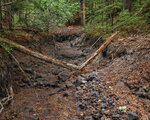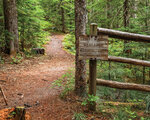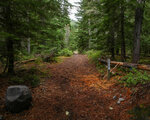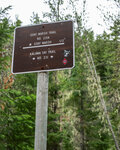




The Goat Marsh area near Mount St. Helens on the north side of Gifford Pinchot National Forest is a research natural area full of biodiversity. Old growth combined with new growth firs and pines create a canopy over a rich understory full of various huckleberries, ferns, lupines and more.
The road that leads to the trail is best driven with a higher clearance vehicle, but a low-clearance vehicle is also possible. After driving on road Forest Service-81 north of the Ape Caves area, take a right turn onto National Forest Road 8123; the trailhead for Goat Marsh appears roughly half a mile up the road. NF-8123 has a consistent wash, likely from snow melt, down the middle that can make it difficult for a low-clearance vehicle.
By driving slowly, the trailhead isn’t impossible to see that one could miss it, but it isn’t the most obvious either. The trailhead is on the left, and parking is not abundant, nor are people. Parking at the trailhead is best achieved along the road but not directly in front of the trailhead as horseback riding is available on the trail until the boundary of the Goat Marsh Research Natural Area.
Once on the trail, people should look out for trail markers in the form of blue squares on tree trunks and white, red and yellow plastic trail ribbons on tree branches. The trail’s distance is 2.4 miles out and back with 275 feet of elevation gain, according to AllTrails. At the beginning, roughly 0.2 miles in, the trail crosses a creek bed, which is dry in August. After that, a sign directs hikers toward Goat Marsh because the first portion of the trail is paired with the Kalama Ski Trail.
At the boundary of the research natural area, a wooden fence and sign reads “Goat Marsh Research Natural Area, Goat Marsh Lake.” After that sign, the trail is for foot traffic only.
Even on a cloudy August morning with Mount St. Helens not visible, plenty of natural beauty was left to see. The area is full of plants native to the area for people interested. Sedge, Western bunchberry, various huckleberries, various lupines, Pacific coralroot orchid and more line the trail. The songs from various bird species and the sudden cry from squirrels and chipmunks break the silence. The feeling of being watched could be considered normal as the trail is in “Bigfoot Country.”
After taking in the forest’s understory, hikers begin to see Goat Mountain. On a cloudy day, the best view appeared short of the total distance of the trail. An obvious spur trail takes one beyond the treeline to get an undisturbed view of the wetland and lake.
“Goat Marsh Research Natural Area [RNA] was established to represent a mosaic of mountain marshlands, swamps, and ponds and a xeric lodgepole pine forest characteristic of mudflow and glacial outwash around Cascadian volcanoes,” according to the Forest Service Pacific Northwest Research Station. “Lodgepole pine dominates pyroclastic flow forests in the harshest areas, Douglas fir and Western hemlock dominate areas with richer soils, and Western balsam poplar dominates the moistest areas. Roundleaf sundew and angelica are two carnivorous species present.”
A permit fee is required to visit this area of the Mount St. Helens National Volcanic Monument. For more information regarding permits, visit fs.usda.gov/main/giffordpinchot/passes-per mits/recreation